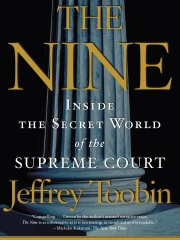The Nine by Jeffrey Toobin
Whether it’s because of age, social media, or the current administration (unlikely), I’ve been paying vastly more attention to politics in the past few years. A striking realization is that I really don’t know how government works. In school, I learned ancient world history several times and spent one intense year on American history, but – in writing this – it just dawned on me that I forgot the existence of AP Gov. In high school, AP Gov was almost known as the inferior version of APUSH. In retrospect, APUSH is to AP Gov as AP Calculus is to AP Stats. You don’t need to know who the 8th president was. You don’t need to know how to take a derivative. But you do need to know how the government works and how to interpret averages.
1) The Warren Court is considered the most liberal court in American history.
The court was responsible for Brown v. Board of Education, Miranda rights, and one man one vote.
2) Following Warren, (Warren) Burger – despite being a conservative – led a Supreme Court to a slew of liberal decisions.
The most important was Roe v. Wade in 1973, a 7-2 decision in which several judges appointed by Republican presidents voted in the majority, while the Democrat-appointed Byron White dissented. To my surprise, Roe v. Wade is based on the idea of the right to privacy. I would have filed it under equal protection of the law.
3) With the confirmation of Clarence Thomas in 1991, 8 of 9 justices were appointed by Republican presidents.
I first learned about the Anita Hill controversy during the Kavanaugh fiasco. Two other facts that I take away about Thomas are that he almost never speaks during oral arguments and that he is against affirmative action even though he is arguably one of its most prominent beneficiaries.
4) My interpretation is that there are four main schools of thought in judicial ruling.
I’m sure this is not the real way to look at jurisprudence (is that even how you use this word?), but these concepts helped me delineate how different justices ruled. Textual: interpret the text of Constitution as is. Originalist: interpret the Constitution according to what the Founding Fathers meant. Political: rule in favor of the opinion held by the majority of Americans. Stare decisis: rule according to precedence.
5) For a case to make it to the Supreme Court, a writ of certiorari must be granted. The first part of the cert contains the questions presented.
I also gathered a loose understanding of how district and circuit courts work.
6) In 1992, Roe v Wade was upheld in Planned Parenthood v Casey in a plurality opinion written by Souter, O’Connor, and Kennedy.
The trimester test was replaced by the concept of viability and the undue burden standard.
7) Bill Clinton almost nominated Mario Cuomo to the Supreme Court, but the NY governor backed out last minute, and RBG became the nominee.
With families like Bushes, Clintons, Cuomos, it’s hard to think the game is fair.
8) Jay Sekulow emerged as a conservative voice by arguing and winning cases on the premise that religious speech is free speech.
Wow I remember reading his Rise of ISIS years ago. Of all the conservatives in this book, Sekulow is painted as the worst villain.
9) Bush v Gore was ultimately decided as a violation of the equal protection clause.
The Bush v Gore debacle takes up a good chunk of the book, for good reason. There are excruciating details, but my main conclusion is that the case truly demonstrates that the Supreme Court is just a group of humans with their own opinions. There is no right or wrong.
10) In Grutter vs Bolliger, the Court ruled 6-3 that affirmative action was allowed as long as other factors were considered.
At the same time, the Court struck down points-based affirmative action. During Grutter, the military and corporations played a large role with their amicus briefs. In particular, the military said that affirmative action was necessary.
This book was an extremely entertaining look at a cast of colorful characters who arguably are some of the most powerful Americans in history. Other than the blatant liberal leaning of the author, I couldn’t find any faults. In many ways, the Supreme Court is seen as the bastion of justice. Even if the rest of the country fell apart, the Court would save us. But that is hardly reality. The Supreme Court is just as political – in fact it is a more concentrated dose of our politics. It is at once the least democratic in its direct presidential appointments and the most democratic in its simple majority decisions. I gained a lot of respect for the Court, and I’m cautiously looking forward to the next justice handover.
